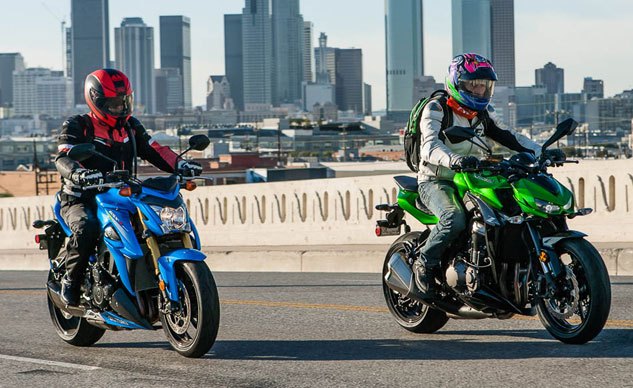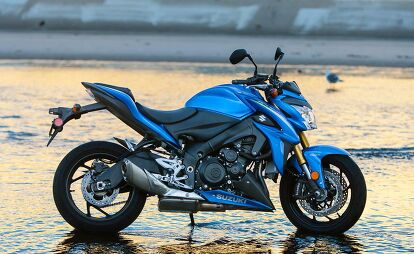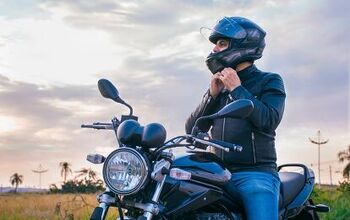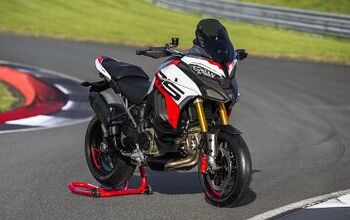Japanese Mega Standards Shootout
Kawasaki Z1000 ABS vs. Suzuki GSX-S1000 ABS
Almost two years to the month, we took our first ride aboard Kawasaki’s new-gen Z1000 ABS ( 2014 Kawasaki Z1000 ABS – First Ride). We were initially impressed, scoring the Z1K a 93% in its single-bike review. Then came our 2014 Streetfighter Shootouts ( 2014 Super Naked Street Brawl, 2014 Super Streetfighter Smackdown) where the Z rounded out the bottom. In all fairness, the Z1K was matched against the most exotic of European nakeds boasting more performance and costlier prices. Even then the Z1K nearly stole third-place podium finishes from the Ducati Monster 1200S.
Enter the 2016 Suzuki GSX-S1000 ABS, a Japanese naked powered by an inline-four-cylinder engine that, on paper, looks to be the Kawi’s equal. Like the Z1000 ABS, John Burns awarded the Gixxus 1K a respectable 86.25% in his First Ride review. But it’s always difficult to take the measure of a motorcycle during a one-day press intro, especially when there’s no competing model with which to measure it by. So, let’s shake the leaves from these two trees, rake them up and see which pile is better to jump into.
As noted, both bikes are powered by inline-Fours. A closer look at each engine’s specs reveals a Kawi motor that’s larger capacity, shorter stroke, bigger bore, and with a 1,000 rpm lower redline compared to the Suzi. During our testing John and I were both of the opinion that the Z1K was the more productive low- and mid-range power producer – accelerating harder out of corners and absolutely walloping the Gixxus in top-gear roll-ons. Our seat-of-the-pants impressions were born out when we strapped each bike to the dyno the following week.
“Kawasaki feels like it has a lot more low-rev power, either that or it’s geared quite a bit shorter,” says JB. “A tooth, maybe two tooths, on the GSX-S’s rear sprocket would wake it right up I bet.” From my 2013 First Ride Impression, I reported that compared to the 2013 Z1000, the rush of forward acceleration is made more prominent by virtue of shorter first-through-fifth gear ratios.
So, more outright power for the Gixxus but more usable power for the Z1K. Almost a wash. Neither bike excelled at smooth power application as both exhibited the kind of lightswitch throttles associated with EFI systems of the past. The Suzuki boasts a type of combined traction control/ride mode technology where setting #2 softens throttle response while delivering maximum horsepower and increasing TC intrusiveness (setting #3 drops power like a rain mode and ups TC), but even in this mode, modulating power was a black or white affair.
Another issue of engine performance is the production of high-frequency vibrations associated with inline-Fours. “People who can’t tolerate engine vibration need to buy a Twin or a Triple, because both of these bikes give off a little four-cylinder vibration; not an objectionable amount from either one, to me, but it’s discernible,” says Burns. The Kawasaki, to me, emits more irritating vibrations than does the Suzuki, enough so that I’ll choose to ride the Gixxus over the Kawi for this reason alone.
The seat on the Suzuki is also a little plusher than the more stylized (Z-stitching) seat of the Kawasaki. Outside of this nitpick, though, both bikes seemed to offer equal comfort, with neither John nor I finding something to complain about. “They both let you get plenty of smooth, quiet airflow, and neither one cooks your thigh meat,” says Burns. “In fact, for the kind of riding I do most of the time, they’re both great utilitarian motorcycles.”
Either bike’s ability to handle uneven pavement is tackled by way of a three-way adjustable fork and a two-way adjustable shock. Maybe it’s the gold anodizing of the KYB fork on the Suzuki, we’re not sure, but both Burns and I preferred the suppleness the Suzuki’s suspension afforded. “For everyday normal commuting, I think I like the Suzuki and its more compliant suspension and cushier seat,” says JB. “The Kawasaki feels sprung a bit stiffer, which is no problem on smooth roads, but I remember the GSX-S suspension feeling a bit overwhelmed on bumpy backroads, but it seems that was true of the Z also.”
Outside of the Kawasaki’s suspension compliance, and its 23 extra pounds, the green bike is definitely swifter in the twisties than the blue one. Tire size and rake/trail figures being (nearly) identical, chalk it up to the Z1K’s one-inch lesser wheelbase and stronger suspension allowing the Kawi to transition from left to right in quicker fashion than its lighter-weight competitor. That’s not to say the Suzuki is slow to corner, but it takes just the slightest bit more effort to induce a lean than does the Kawi. The tradeoff being a margin more straightline stability for the GSX-S.
Without the convenience of riding these two back-to-back, you’d never know these minor differences in handling characteristics exist. If you’re looking to make a purchase between the two, it’s a simple matter of the Kawi being a little quicker to turn and the Suzuki having a minor amount more stability. If you’ve a preference between the two attributes, that could be the deciding factor in your purchasing decision.
When it came time to stop the two naked literbikes, we were in store for another surprise. Like the Suzuki’s price advantage, it’s not often we get to say that a non-Brembo brake was the clear favorite. Between the self-branded calipers of the Kawasaki to the Brembo ones on the Suzuki, we both found the Brembos requiring much more pressure at the lever to apply the same amount of stopping power as those on the Kawasaki. Chalk it up to inferior brake pads or air in the lines for Suzuki’s Brembos, or just flat out better stopping performance for the Kawi, after riding the Z1K, stopping the Suzuki took an obvious amount of extra effort.
The 2016 Kawasaki Z1000 ABS retains the same $11,999 MSRP as it did since the revamped model’s introduction in 2014. Kudos to Team Green for holding steady instead of issuing the gratuitous annual $100 or $200 price hikes. But in the face of the Gixxus and its MSRP of $10,499, it’s hard to justify spending the extra dough. The Kawasaki exhibits some advantages, but like JB mentioned earlier, it’d be easy to pep up the GSX-S’s drive by adding a tooth or two to the rear sprocket, providing more direct access to that 144 horsepower. You could also upgrade its braking performance with some aftermarket pads, and quicken its transitioning by dropping rear tire size from its stock 190/50-17 to a 190/55 or 180/55-17.
Kawasaki Z1000 ABS
+ Highs
- Quick in the corners
- Low- and mid-range power
- Great brakes
– Sighs
- Love it or hate it styling
- Stiff suspension
- Comparatively pricey
In retrospect, maybe I was a little too generous in my initial first-ride review of the Z1000 while John a little too stingy in scoring the Gixxus in his first-ride review. Now that we’ve put the two together, it was unanimous between us and the ScoreCard that the Suzuki is the clear winner between them. Being the spendthrifts we are, it’s not surprising we see the financial benefits of purchasing the lesser expensive bike and spending the little it’d take in aftermarket upgrades to perfect its imperfections.
Suzuki GSX-S1000 ABS
+ Highs
- $1,500 less than Z1K
- More Comfort
- Less Vibes
– Sighs
- Peakier engine
- Slightly less agile
- Lacking initial front brake bite
I’ve had my say. I’ll let Burnsie walk this one out.
“Other than the coming apocalypse, I think they’re both great bikes for the money, but I think the Suzuki is greater because it’s less money. They’re both supremely comfy due to their standard-bike ergos, but for me the Suzuki’s just a bit nicer, it’s instruments a little easier to read. It also makes huge horsepower and weighs two pounds less than the $17k Aprilia Tuono Factory we put on the scales the same day. I could never buy a motorcycle without the looks of the thing being a big consideration, and I like this Suzuki. I won’t voice my opinion of the Z again, except to say it makes me think of some sort of weird sea serpent with a saggy old bosom covered in bass-boat paint.”
Japanese Mega Standards Shootout Scorecard | |||
|---|---|---|---|
| Category | Kawasaki Z1000 | Suzuki GSX-S1000 | |
| Price | 87.5% | 100% | |
| Weight | 95.3% | 100% | |
| lb/hp | 84.2% | 100% | |
| lb/lb-ft | 96.8% | 100% | |
| Total Objective Scores | 91.1% | 100% | |
| Engine | 85.0% | 86.3% | |
| Transmission/Clutch | 83.8% | 83.8% | |
| Handling | 86.3% | 85.0% | |
| Brakes | 88.8% | 82.5% | |
| Suspension | 81.3% | 86.3% | |
| Technologies | 77.5% | 83.8% | |
| Instruments | 77.5% | 85.0% | |
| Ergonomics/Comfort | 83.8% | 88.8% | |
| Quality, Fit & Finish | 85.0% | 85.0% | |
| Cool Factor | 77.5% | 82.5% | |
| Grin Factor | 86.3% | 85.0% | |
| Roderick’s Subjective Scores | 83.1% | 84.4% | |
| Burns’ Subjective Scores | 83.1% | 85.6% | |
| Overall Score | 84.7% | 88.0% | |
Japanese Mega Standards Shootout Specifications | ||
|---|---|---|
| Kawasaki Z1000 ABS | Suzuki GSX-S1000 ABS | |
| MSRP | $11,999 | $10,499 ($9,999 non-ABS) |
| Horsepower | 129.6 hp @ 10,400 rpm | 144.4 hp @ 11,700 rpm |
| Torque | 77.2 lb-ft @ 7,600 rpm | 76.3 lb-ft @ 9,400 rpm |
| Engine Capacity | 1,043cc | 999cc |
| Engine Type | Four-stroke, 4-cylinder, DOHC, 16-valve, liquid-cooled | Four-stroke, liquid-cooled, DOHC, inline-four |
| Bore x Stroke | 77.0 mm x 56.0mm | 73.4mm x 59.0mm |
| Compression | 11.8:1 | 12.2 : 1 |
| Fuel System | EFI | EFI |
| Transmission | 6-speed constant mesh | 6-speed constant mesh |
| Clutch | Wet, multi-plate | Wet, multi-plate |
| Final Drive | O-ring type, sealed drive | O-ring type, sealed drive chain |
| Front Suspension | 41mm inverted SFF-BP fork with stepless compression and rebound damping and spring preload adjustability / 4.7 in | 43mm KYB fully adjustable telescopic fork, 4.7-in. travel |
| Rear Suspension | Horizontal monoshock with stepless rebound damping, adjustable spring preload / 4.8 in | KYB link type single shock with rebound and preload adjustment, 5.1-in. travel |
| Front Brakes | Dual 310mm petal-type rotors with radial-mounted four-piston monobloc calipers and ABS | Dual 310mm semi-floating disc, Brembo radial-mount 32mm four-piston caliper |
| Rear Brakes | Single 250mm petal-type rotor with single-piston caliper and ABS | Single 220 mm disc, one-piston Nissin caliper |
| Front Tire | 120/70ZR-17 | 120/70ZR-17 |
| Rear Tire | 190/50ZR-17 | 190/50ZR-17 |
| Seat Height | 32.1 in. | 31.9 in. |
| Wheelbase | 56.5 in. | 57.5 in. |
| Rake/Trail | 24.5 ° / 4.0 in. | 25.0°/3.9 in. |
| Curb Weight | 488 lbs | 465 lbs |
| Fuel Capacity | 4.5 gal. | 4.5 gal. |
| Electronics | ABS | ABS, Traction Control |
| Colors | Golden Blazed Green / Metallic Spark Black | Metallic Triton Blue |
| Warranty | 12 Month Limited Warranty | 12-month, unlimited miles |
A former Motorcycle.com staffer who has gone on to greener pastures, Tom Roderick still can't get the motorcycle bug out of his system. And honestly, we still miss having him around. Tom is now a regular freelance writer and tester for Motorcycle.com when his schedule allows, and his experience, riding ability, writing talent, and quick wit are still a joy to have – even if we don't get to experience it as much as we used to.
More by Tom Roderick
































































































































Comments
Join the conversation
With it's greater high speed stability and top end power, the GXS sounds like a good high speed sweeper kind of bike. Genuinely pleased to see 144 stock EPA legal ponies from the legendary Suzuki K5 engine. It seems Suzuki did not smack it completely senseless with the dumb down stick.
Drop a tooth on the front sprocket, add a Power Commander, Akrapovich full exhaust and some decent front brake pads and the new Suzuki is the kind of bike that would likely make me happy for a long time. The current ride is a bought new in '06 FZ1 with that mod list, (plus a Penske shock) and I love the thing.
With their decent handling, plentiful power, relative affordability and unbreakable Japanese reliability, this kind of motorcycle really is a do it all fun and fuss free ride. Pick your brand/style, and rock on!
I was able to demo the z1000 last summer and if they had one in stock I would have taken it. Vibes were noticeable at around 6k but not terrible.